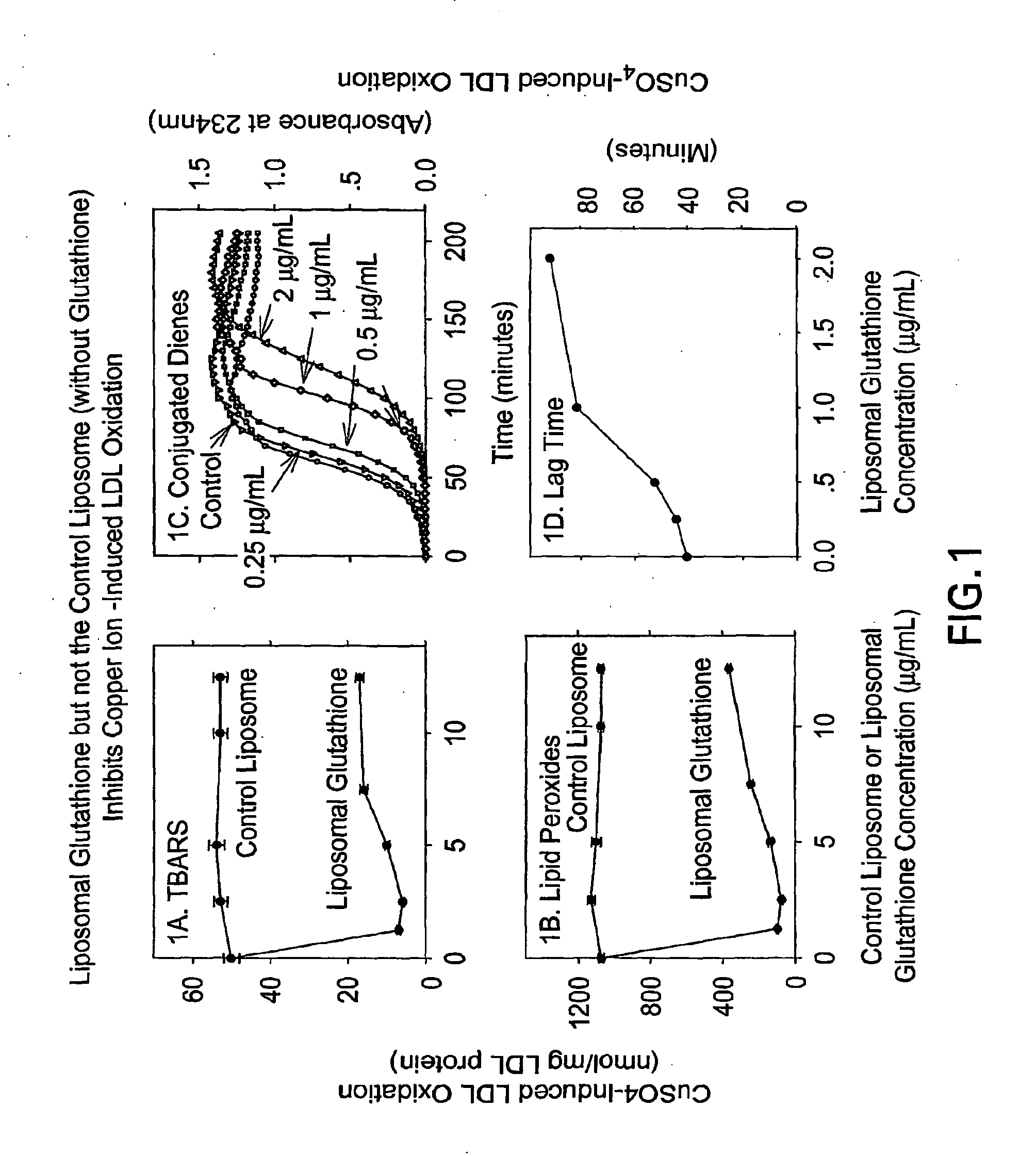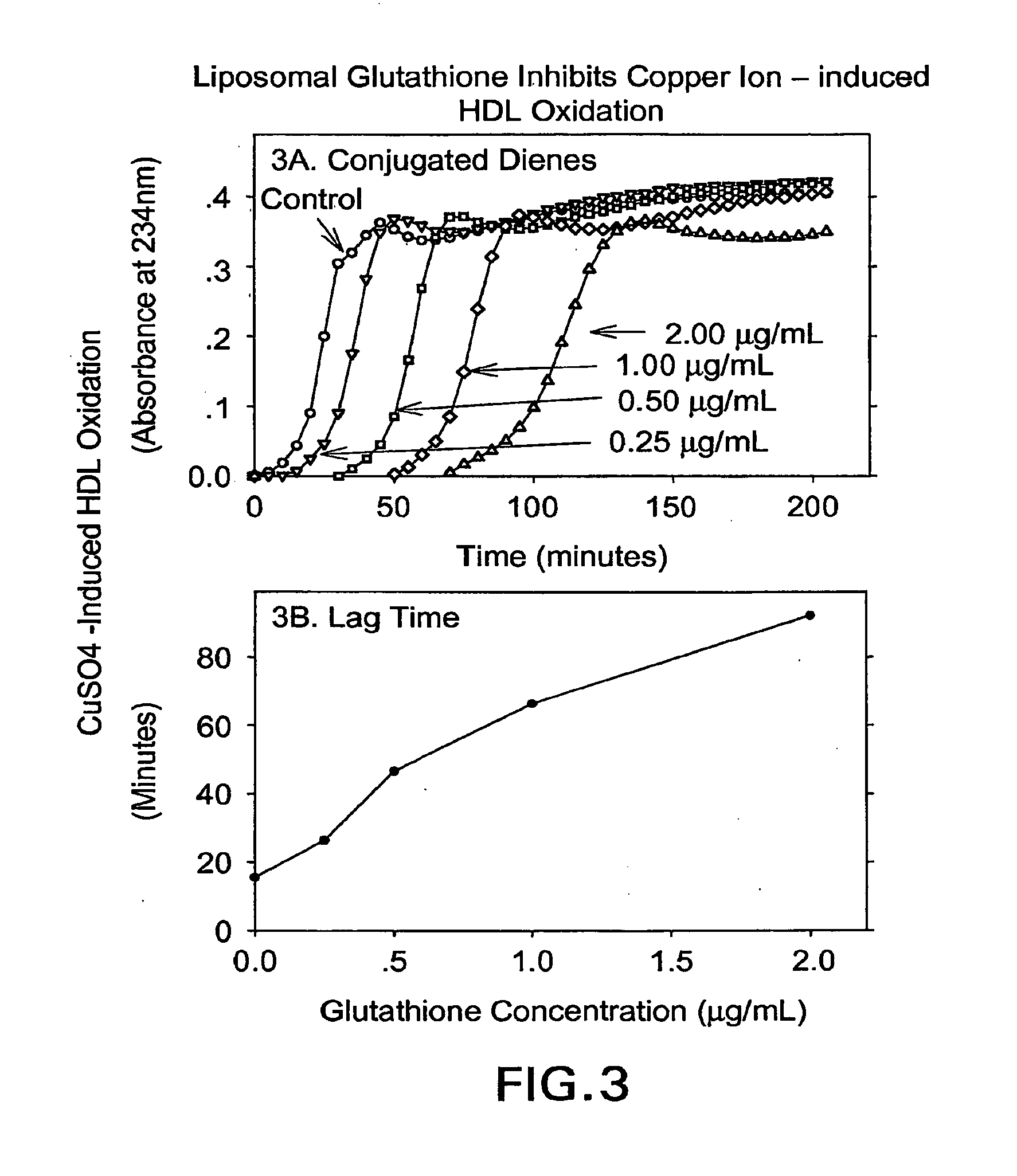Liposomally Encapsulated Reduced Glutathione, including with Other Pharmacologic Preparation, Capable of Administration as an Oral, Topical, Intraoral or Transmucosal, Prepartion, for Reversal and Prevention of Oxidation of Cholesterol and of Low Density Lipoprotein
a technology of liposomal encapsulation and reduced glutathione, which is applied in the field of liposomal encapsulated reduced glutathione, can solve the problems of increased risk of coronary artery disease, cells and tissues, and increased fatty material elevation
- Summary
- Abstract
- Description
- Claims
- Application Information
AI Technical Summary
Benefits of technology
Problems solved by technology
Method used
Image
Examples
example 1
[0100]An unpublished study of “The effect of liposomal glutathione on the oxidation of the cholesterol components known as Low density lipoprotein (LDL) and high density lipoprotein (HDL)” was performed by Professor Michael Aviram The Lipid Research Laboratory Rambam Medical Center, Haifa Israel, which demonstrates the novelty of the invention and its effect on LDL oxidation and on HDL oxidation.
Methods
[0101]Liposomal Glutathione composition: The Liposomal Glutathione solution consisted of: 8.25% reduced glutathione (GSH, 84.5 mg / mL), 75.15% deionized water, 15% glycerine, 1.5% lecithin, and 0.1% potassium sorbate (on a % weight / weight basis). Control Liposomes consisted of similar composition, but without reduced glutathione. Lipoproteins isolation: Low density lipoprotein (LDL) and high density lipoprotein (HDL) were isolated from the serum of normolipidemic volunteers by density gradient ultracentrifugation. The LDL and HDL protein concentration was determined by the Lowry method...
example 2
[0116]CP is an 11 year old boy who presented with a 6 month history of persisting fatigue. Prior to his illness, he was actively involved with school and sports. In sports he ran cross country, played soccer and baseball. At the time of his initial evaluation, his activity was restricted to partial days at school and no physical activity. With physical activity he became exhausted and was not able to keep up his school work. The onset of his symptoms in the spring of the year coincided with what were thought to be cold symptoms with recurring rhinitis followed by an ear infection in the late summer. He had seasonal allergies, which started 2 years prior to the current illness.
[0117]At the initial evaluation the working diagnosis was chronic viral illness related to Epstein-Barr Virus (EBV). His physical exam revealed nasal congestion with inflammation of the nasal mucosa and an enlarged spleen. His viral antibody evaluation revealed significant elevations of:[0118]IgG Antibody to EB...
example 3
[0128]Patient C is a 67 year old in the late stages of prostate cancer, who became depressed, weak and wanted to die. His condition was and is terminal and all therapy and most supportive care had been withdrawn. He was down to sips of water for days on end. Patient C was given the current invention, liposomal glutathione (reduced) one teaspoon Three times a day (400 mg. per teaspoon) for a total of 1200 mg per day. Each teaspoon was diluted in 2 ounces of apple juice. 10 hours later; the next day, the patient was observed to have a significant improvement in general outlook, reporting a significant lessening of depression and pain, and over-all vigor that led to a dramatic improvement in his condition that lasted for several days. Unfortunately, this effect was not permanent. The improvement observed lasted about 6 days.
[0129]For background information on the effect of liposomal glutathione on neurotransmitters, the reader is referred to Guilford U.S. patent Ser. No. 11 / 420,168 fil...
PUM
| Property | Measurement | Unit |
|---|---|---|
| size | aaaaa | aaaaa |
| concentrations | aaaaa | aaaaa |
| concentrations | aaaaa | aaaaa |
Abstract
Description
Claims
Application Information
 Login to View More
Login to View More - R&D
- Intellectual Property
- Life Sciences
- Materials
- Tech Scout
- Unparalleled Data Quality
- Higher Quality Content
- 60% Fewer Hallucinations
Browse by: Latest US Patents, China's latest patents, Technical Efficacy Thesaurus, Application Domain, Technology Topic, Popular Technical Reports.
© 2025 PatSnap. All rights reserved.Legal|Privacy policy|Modern Slavery Act Transparency Statement|Sitemap|About US| Contact US: help@patsnap.com



